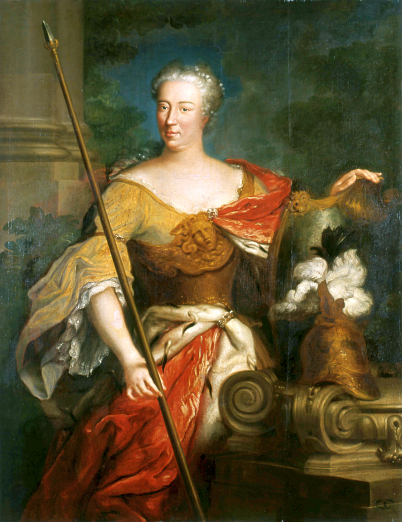Sieniawska Elżbieta, née Lubomirska
Sieniawska Elżbieta, née Lubomirska (1669–1729)
Parents:
Zofia née Opalińska and Stanisław Herakliusz Lubomirski
Husband:
Adam Mikołaj Sieniawski, voivode of Bełz Voivodeship, Field Crown Hetman, Great Crown Hetman, Castellan of Kraków
Children:
-Maria Zofia née Sieniawska I voto Denhoff, II voto Czartoryska
Elżbieta Sieniawska, née Lubomirska (d. 1729), was considered very well-educated. The wife of Hetman Adam Sieniawski, was a woman of vast interests, an intelligent female, curious about the world: she had a sharp eye and frequently a biting pen. Together with her husband Adam Mikołaj (d. 1726), contributed many church foundations. The person of the protector, her protective means (affinities, finances, offices held, closeness with the court) as well as temperamental traits (accessibility, joviality, openness) proved to be important. Under her eye cultural patronage in the form of protection over a narrow artistic milieu of her Estate (architects, painters, musicians, printers, newspaper editors) was established. The long-time developed religious patronage over religious institutions and their representatives (monastic congregations and brotherhoods, churches, chapels), was also visible.
Court:
When her husband, Adam Mikołaj Sieniawski (d. 1726) was still alive the matron was highly active in economy, and did not cease to act even after her husband’ death; she took over as managers of their estates and Crown lands. In her endeavours, she showed a great deal of energy, ruthlessness, intuition, reflexes, and extraordinary economic skills.
She provided with all information about the economic condition of her folwarks and harvest by her administrators, who constituted a highly hierarchised society. The highest echelon was occupied by a magnate, followed by officials, economists, courtiers, chamber grooms, and, as the last in chain, casual servants called barwa. She hired trusted and reliable administrators of her lands and estates in Sandomierz and Kraków suburbs. They were as follows: Piotr Morzycki (d. May 1725); his successor Andrzej Zabagłowicz (d. after 1733); Józef Łukszycki, an economist of Jarosław (d. after 1729); and Izaak Rubinowicz, an official of Sandomierz (d. after 1742). Elżbieta Sieniawska managed her properties with the assistance of extensive correspondence with her administrators, from whom she expected information not only about the financial state of particular klucze (keys, meaning “key properties”), but also about everything that happened there. She paid particular attention to regular mail and she was very scrupulous in this matter herself.
To a great extent, magnate and noble families depended on their extensive lands designated mainly for agriculture. Vegetables and fruit grown in the court gardens and orchards were dealt with in a similar fashion. After picking, they were properly prepared, processed, and they ended up on the dining table, in the pantry, or they were used as herbal remedies. Just like crops, any surplus of fruit or vegetables was sold. Animal farming (cows, bulls, horses, goats, pigs, sheep) was a substantial part of agriculture. It provided the household not only with meat but also wool, animal skin, and dairy produce, contributing to a significant development of dairy and fabric production. These elements allowed folwarks to function independently, and in fertile years they generated high sale income.
At Elżbieta Sieniawska née Lubomirska’s estates, the level of agriculture development was very high, which was undoubtedly her own achievement. The most successful folwarks were located in Łubnice, Rytwiany, Oględów, Sichów, Budziszki, and Orłów. Generally, some amounts of crops and seeds were used for sowing the fields and gardens in the following year. The folwarks hired economists who had constant supervision over farming. Apart from the agriculture, both poultry and cattle farming developed at Sieniawska’s estates. The cattle were mainly Dutch, and specially assigned administrators were responsible for their import.
Industry was another important area of her activities, and it is clearly reflected in her endeavours. Mainly, it focused on the supervision of the production and sale of the goods manufactured at the estates, establishment of mills, breweries, distilleries, brick factories, smithies, and specialised metallurgy and weaving manufactories. Usually, buildings like these were taken into consideration while designing a whole court infrastructure. Moreover, erecting court close to rivers facilitated machinery work, delivery of raw materials necessary for production, and rafting ready goods to main trade centres.
See also:
Działalność Elżbiety Sieniawskiej. Polityka – Gospodarka – Kultura, red. B. Popiołek, Warszawa 2020
B. Popiołek, Dobrzy chłopi i źli panowie. Kwestia opieki na poddanymi w korespondencji Elżbiety Sieniawskiej, kasztelanowej krakowskiej, [w:] Epistolografia w dawnej Rzeczypospolitej, T.VI: (stulecia XVI–XIX) Nowa perspektywa historyczna i językowa, red. P. Borek i M. Olma, Kraków 2015, s.254–278
B. Popiołek, Zamiana ról. Królowa Maria Kazimiera d’Arquien Sobieska i Elżbieta z Lubomirskich Sieniawska, kasztelanowa krakowska, [w:] Maria Kazimiera Sobieska (1641–1716). W kręgu rodziny, polityki i kultury, red. A.Kalinowska, P.Tyszka, Warszawa 2017, s.167–194
U. Kicińska, Codzienne obowiązki zarządcy majątku – na przykładzie korespondencji Piotra Morzyckiego do Elżbiety z Lubomirskich Sieniawskiej, [w:] Epistolografia w dawnej Rzeczypospolitej, T.VI: (stulecia XVI–XIX) Nowa perspektywa historyczna i językowa, red. P. Borek i M. Olma, Kraków 2015
 Women's noble court in the Polish-Lithuanian Commonwealth in the Saxon times. Structure, people, culture, functions
Women's noble court in the Polish-Lithuanian Commonwealth in the Saxon times. Structure, people, culture, functions

